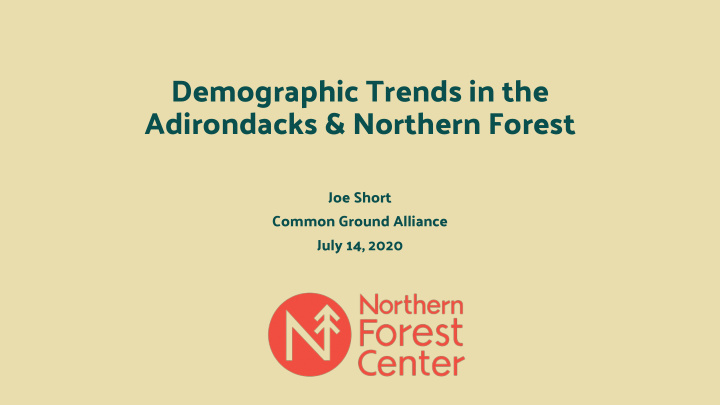



Demographic Trends in the Adirondacks & Northern Forest Joe Short Common Ground Alliance July 14, 2020
Overview • Population • Density • Change over time • Components of Change • School Enrollment • Racial Diversity • Case example for attracting new residents
Source Data for this Presentation: Demographic Change in the Northern Forest, presentation commissioned from Dr. Kenneth Johnson, University of New Hampshire Carsey Institute, March 2018 4
Credit: Demographic Change in the Northern Forest, presentation by Dr. Kenneth Johnson, University of New Hampshire Carsey Institute, March 2018
Credit: Demographic Change in the Northern Forest, presentation by Dr. Kenneth Johnson, University of New Hampshire Carsey Institute, March 2018
Credit: Demographic Change in the Northern Forest, presentation by Dr. Kenneth Johnson, University of New Hampshire Carsey Institute, March 2018
Components of Population Change 2010-2016 • Net Migration: In- vs out-migration • Net loss from migration • Out-migration largely by younger people, and in-migration, when it occurred, by older people. • Natural Increase: Births-Deaths • Most of the Adirondack region has decrease or minimal (<0.5%) increase 9
Data source: National Center for Education Statistics - http://nces.ed.gov/ccd/elsi/
All nonmetro manufacturing counties in US Credit: Demographic Change in the Northern Forest, presentation by Dr. Kenneth Johnson, University of New Hampshire Carsey Institute, March 2018
Influx of family age adults Influx of older adults All nonmetro recreation counties Credit: Demographic Change in the Northern Forest, presentation by Dr. Kenneth Johnson, University of New Hampshire Carsey Institute, March 2018
Credit: Demographic Change in the Northern Forest, presentation by Dr. Kenneth Johnson, University of New Hampshire Carsey Institute, March 2018
Credit: Demographic Change in the Northern Forest, presentation by Dr. Kenneth Johnson, University of New Hampshire Carsey Institute, March 2018
Child diversity much higher than adult Credit: Demographic Change in the Northern Forest, presentation by Dr. Kenneth Johnson, University of New Hampshire Carsey Institute, March 2018
Case Example: Millinocket, ME 16
Getting on the Map
Building the Recreation Economy 18
Strengthening Civic Institutions 19
Strengthening ‘Third Places’ 20
Creating Quality Housing To Katahdin Woods and Water NP To Baxter State Park 4. 104 Oxford Street 1. 26 Central Street Millinocket Public Library Granite Street Elementary School Great Northern Paper Mill Site Millinocket Regional Hospital 5. 100 Katahdin Avenue 3. 175 Aroostook Avenue 2. 9 Penobscot Avenue 6. 56 Congress Street
Creating Quality Housing 22
Deliberate, Integrated Investment 23
What We’ve Learned Invest in stacke ked and conn nnec ected ted proje ject cts that attract and retain younger entrepreneurial people Recreational trails and assets from towns Reliable and affordable high speed internet and cell coverage Authentic, diverse and walkable communities Activities and places that create relationships among visitors and residents Quality rental housing and co-working space Build on local leadership, vision and momentum Harness new forms of public, philanthropic and private investment 24
PSA: Participate in the 2020 Census! https://2020census.gov Questions? Use the Q&A function on your screen.
Recommend
More recommend